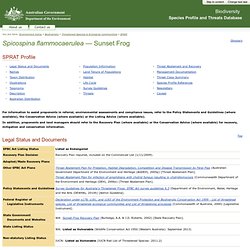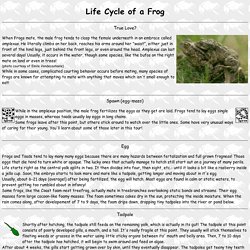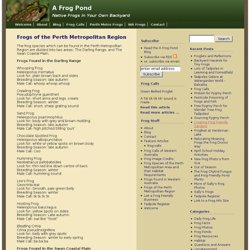

Spicospina flammocaerulea — Sunset Frog. For information to assist proponents in referral, environmental assessments and compliance issues, refer to the Policy Statements and Guidelines (where available), the Conservation Advice (where available) or the Listing Advice (where available).

In addition, proponents and land managers should refer to the Recovery Plan (where available) or the Conservation Advice (where available) for recovery, mitigation and conservation information. Scientific name: Spicospina flammocaerulea Common name: Sunset Frog The Sunset Frog is a black or very dark grey frog growing to 35 mm. It has bright reddish-orange hands and feet as well as orange patches below the anus and margins to jaws. The Sunset Frog was discovered in 1994. The Sunset Frog has a limited extent of occurrence, approximately 305 km² (Burbidge & Roberts 2001; Roberts et al. 1999).
The area of occupancy for this species is 135 hectares (Burbidge & Roberts 2001; Roberts et al. 1999). Raising Tadpoles to Adulthood. Petri Dish Culture Stage 1 to Stage 43 Growth Media After fertilization, embryos are kept in 150 mm Petri dishes, in approx. 75 – 100 ml 1/9 X Modified Ringers solution.

Gentamicin is added at a dose of 100 micrograms/ml to retard bacterial growth. We keep a gentamicin 1000x stock at 4ºC. Number per dish The number of embryos in a dish is critical to survival. Cysteine A light treatment of 2-3% cysteine will partially remove the jelly coat from the embryos and cause them to dissociate slightly. Note: If a high degree of non-viability is expected (from poor fertilization, gamma irradiation or other mutagenesis), maintaining the jelly coat can be an advantage. Death It is important to remove the dead and dying embryos from the dish to prevent the growth of bacteria, especially if the embryos have been treated with cysteine. Life Cycle of a Frog. True Love?

When Frogs mate, the male frog tends to clasp the female underneath in an embrace called amplexus. He literally climbs on her back, reaches his arms around her "waist", either just in front of the hind legs, just behind the front legs, or even around the head. Amplexus can last several days! Usually, it occurs in the water, though some species, like the bufos on the right mate on land or even in trees! (photo courtesy of Emile Vandecasteele) While in some cases, complicated courting behavior occurs before mating, many species of frogs are known for attempting to mate with anything that moves which isn't small enough to eat! Spawn (egg-mass) VFG > Feature articles > A Guide To Keeping Tadpoles. Written by Joanne Doherty and Gerry Marantelli of the Amphibian Research Centre in Melbourne.

Originally published in "In the Spotlight". Introduction We are often contacted by people wanting to keep tadpoles or experience the magic of metamorphosis. The tadpole tank has become popular culture in the schoolroom yet the sorts of brief descriptions of tadpole rearing in publications available to most schools leave a lot to be desired. As a consequence a potentially positive experience can be spoiled and it is often too late when a teacher or taddie raiser calls us for assistance. Protection of frogs and tadpoles It should be remembered that all frogs and tadpoles are protected in Victoria and some other states. About. We built our first suburban frog pond five years ago.

My sister gave us an old fibre glass pond that we dug in to the garden. We enrolled ourselves on the frog register of the Museum of Western Australia. The Museum has a system of connecting people with tadpoles to people wanting to establish native frog ponds. We received a call a few weeks later to tell us an address where we could gather some motor bike frog tadpoles. We took the children and caught our tadpoles out of a big privately owned pond system. We released them into our pond and the kids had so much fun catching them and releasing them for weeks after. It has been such a great experience for our whole family that I have decided to document our experience.
I’d love to hear about your frog pond. Frogs of the Perth Metropolitan Region. The frog species which can be found in the Perth Metropolitan Region are divided into two areas: The Darling Range, and The Swan Coastal Plain.

Frogs Found in the Darling Range Whooping Frog Heleioporus inornatus Look for: plain brown back and sides Breeding Season: late autumn Male Call: whoop whoop whoop Crawling Frog Pseudophryne guentheri Look for: short arms and legs, crawls Breeding Season: winter Male Call: short, sharp grating sound Sand Frog Heleioporus psammophilus Look for: body with grey and brown mottling Breeding Season: late autumn Male Call: high pitched trilling ‘purr’ Chocolate Spotted Frog Heleioporus albopunctatus Look for: white or yellow spots on brown body Breeding Season: late autumn Male Call: Coo. Motorbike Frog. Motorbike-Frog-Fact-Sheet.pdf (application/pdf Object) Frogs Australia Network - Home. Alcoa Frog Watch WA. Frogs of Australia > Western Australia > The frogs of Western Australia. FrogWatch.